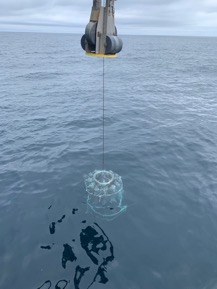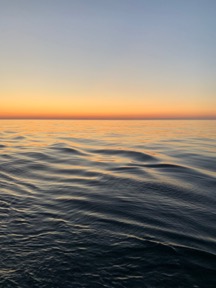by Sarah Nickford, URI
Greetings from the R/V Neil Armstrong! I am a graduate student studying physical oceanography at the University of Rhode Island’s Graduate School of Oceanography. Originally, I planned on participating in the OSNAP-23 cruise to help calibrate and deploy oxygen sensors on some of the OSNAP moorings in the Labrador Sea as part of the newly funded Gases in the Overturning and Horizontal circulation of the Subpolar North Atlantic Program (GOHSNAP) awarded to my advisor, Dr. Jaime Palter, and her collaborators.
In the midst of the pandemic, I suddenly became an alternate for that cruise as science parties were slashed in half. After completing the 14-day self-isolation as an alternate, the entire science party tested negative for COVID-19 (phew) and the R/V Neil Armstrong began its voyage to the Labrador Sea. I resumed my “normal” pandemic day-to-day life until one morning, not long after, I was asked if I would be willing to complete another self-isolation period to be able to go to the Irminger Sea as a Hydrographer for the next OSNAP cruise. This cruise was a joint venture between OOI and OSNAP, with both OOI Irminger Node and OSNAP mooring turn-arounds. I had about a day to make a decision. Fond memories of my month aboard the SSV Corwith Cramer crossing the North Atlantic with Sea Education Association (SEA) helped me make up my mind. Ever since that voyage, I’ve been drawn to going to sea, where there is no land in sight. So, when the opportunity presented itself, I was eager to help out. I immediately was trained in Woods Hole and after the weekend, I entered my second self-isolation period of the summer. As I learned more about the cruise activities, I became increasingly excited. I suddenly had the opportunity to learn how to collect water samples, watch mooring turn-around operations and help document them, watch glider deployments, and help deploy an Argo float.
After the science party completed their 15-day self-isolation period, we finally arrived and settled into the R/V Neil Armstrong. We left Woods Hole, MA on Saturday August 8th at 0815 and the science team has been busy planning mooring operations, CTD deployments, and water sampling. Today is the fifth transit day and we are just past Canada, making a sharp turn north and heading to the Irminger Sea. So far, we’ve had incredibly clear skies in the evenings, creating the perfect conditions for beautiful sunsets and vibrant stargazing (great for viewing the Milky Way and the Perseid meteor shower!).
The first bit of science was on Saturday afternoon when we did a shallow water CTD cast to test how the CTD and associated machinery were working and so that the OSNAP Chief Scientist, Heather Furey, and I could practice water sampling. We have been orienting ourselves in the wetlab onboard and developing a sampling plan that fits the needs of both the OSNAP project and the OOI Irminger Array. After a CTD comes back on deck, we will be collecting water samples for the following parameters: dissolved oxygen, salt, DIC/TA, pH, nutrients, and chlorophyll. Each sample is taken at a specified depth, which can change depending on the water mass characteristics that we are sampling. We plan to do a CTD cast near each of the OSNAP moorings. This is useful for the calibration of the instruments on the new moorings and for what is called a “post-recovery caldip,” where the instruments from the recovered mooring are strapped to the CTD frame for one final dive to detect possible sensor drift over the two years they lived underwater collecting data. As we continue our transit, we are looking forward to the excitement that is soon to come.

A CTD just below the surface of the water. Before sending the CTD to the depths of the ocean, it must sit at the surface so that the instruments equilibrate with the surrounding water. After reaching its target depth, on its way back up to the surface, scientists monitoring the CTD close individual bottles at specified depths, capturing a sample of water from different water masses.

Reflections of the dwindling daylight on the surface of the ocean after departing Woods Hole.